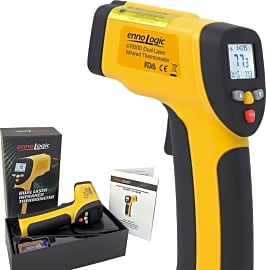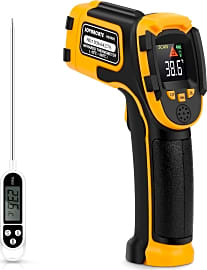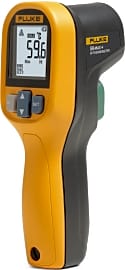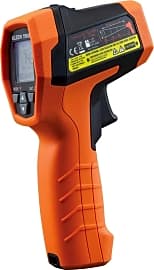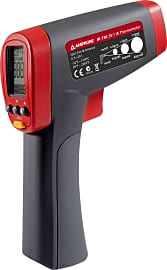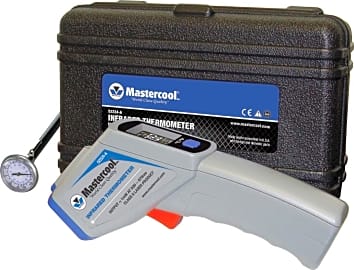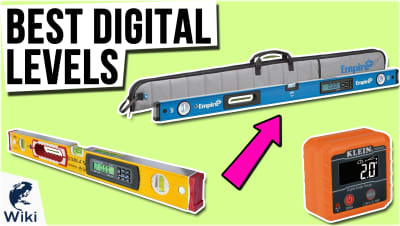The 10 Best Infrared Thermometers

This wiki has been updated 39 times since it was first published in March of 2016. While most of these infrared thermometers aren't designed to check if your little one has a fever, they are quite useful for non-contact applications in the construction, automotive, and culinary fields. Their IR beams can measure minimum, maximum, and average temperatures of stationary objects, making it easy to calibrate expensive cooking equipment or detect hot spots and leaks in HVAC systems. When users buy our independently chosen editorial choices, we may earn commissions to help fund the Wiki.
Editor's Notes
November 12, 2020:
The Nubee Dual Laser has been removed due to availability issues. I also made the determination to remove the BTMeter Digital. I understand that this one offers a 50-to-one distance-to-spot ratio, but I felt that its overall accuracy leaves something to be desired.
Newly added this year is the affordable Sovarcate HS960D, which makes use of a Fresnel lens to focus its infrared light beam onto a specific targeted area for pinpoint accuracy. I thought this was a pretty useful feature, given that such lenses are typically used for lighthouses and searchlights. As an added bonus, this one also comes with a dedicated meat thermometer.
I've also included the Klein Tools IR10 for its ability to accept K-type thermocouple probes, to measure bulk temperatures of gases and liquids, and its audible and visual alarms that alert you when its measurement readings fall outside of a preset range.
Finally, the Mastercool 52224 has a convenient auto shutoff function, while its batteries can provide up to 14 hours of continuous runtime.
August 23, 2019:
Unlike a standard digital thermometer, the infrared thermometer is designed to measure temperature ranges, differences, and averages without actually coming into direct contact with the stationary object it's measuring. How would this be useful? Well, consider that a traditional thermometer doesn't typically measure the temperature of objects that could potentially be dangerous to touch without protective equipment. As an example, let's imagine you're diagnosing a problem with an electrical system. As an electrician, you're not about to use a digital thermometer designed to take your kid's temperature as a means of detecting faulty wires. In addition to a handy pair of electrician gloves, you're going to use something more robust with an ability to measure the temperature of those wires from a distance. One of these infrared thermometers can give you the accuracy needed to determine temperature differences and whether there may be faulty wires around the house. Granted, this is just one example of the tool's application, but you can understand and appreciate the distinction between it and its more traditional counterpart.
The Fluke 561 is one exception on the list, given that its two-in-one design allows it to measure temperatures by non-contact and direct contact. It also comes with a thermocouple pipe probe. I thought the Etekcity Lasergrip was a worthy option, thanks to its ability to scan, hold, and record live data while also displaying the average temperature between two measurement points. I added the BTMeter Digital for its 50-to-one distance-to-spot ratio and built-in flashlight. The Flir TG56 Spot is extremely intuitive, thanks to its color display and graphical menu interface. The compact design of the Fluke 62 Max Plus makes it easy to clip onto most tool belts. It is also both water- and dust-resistant. Because of its fast response time, adjustable emissivity, and dual laser pointers, the EnnoLogic ET650D is a great option for calibrating cooking appliances. I also included the Amprobe IR-730 for its ability to simultaneously display the current, maximum, and minimum temperatures recorded from an object, making it well-suited for helping you find hot and cold spots in HVAC systems or pipes. Finally, I included the Nubee Dual Laser for its programmable high and low temperature alerts.
Special Honors
Wahl DHS520L1 As part of the company's Heat Spy series, the Wahl DHS520L1 is an expensive, high-precision infrared thermometer designed to provide accurate high-temperature readings in the range of 1,022 to 5,432 degrees Fahrenheit. It includes Bluetooth and USB connectivity for data sharing with various mobile devices and computers, data trending and analysis software, and a dedicated operating mode for using preconfigured routes to ensure precise readings in all locations. palmerwahl.com
East Badges Temperature Screening and Checking Kiosk While you wouldn't necessarily depend on it to detect thermal leaks or check the performance of your cooking appliances, the Temperature Screening and Checking Kiosk by Easy Badges can provide plenty of other practical benefits for your place of business, especially if you're concerned about people showing up sick. Preconfigured for plug-and-play operation, this freestanding device requires no internet connection or labored setup process. Its integrated infrared temperature sensor and detection algorithms provide you with an alert when a user is running a fever. Additional advanced features include facial recognition, email notifications with screenshots, and remote monitoring capabilities. It can scan users at a distance range of between 20 and 39 inches and delivers a one-second refresh rate. easybadges.com
A More Powerful Thermometer
Most of these devices use a laser pointer to measure an exact area.
When most people think of thermometers, the small devices that they place in their mouths or on their foreheads to check if they have a fever, are likely the first things that come to mind. Yet, while these medical thermometers are very effective for checking a person's body temperature, they aren't useful for many other applications. Not only do they have a limited measurement range, but they are also contact devices, meaning they require direct contact with whatever surface they are measuring. This makes them impractical to use with objects that get hot enough to melt metal or plastic. For situations where you need to measure the temperatures of objects from a distance, you should consider a good infrared thermometer.
How exactly does an infrared thermometer measure the temperature of an object without being in direct contact with it? Each object in the world radiates thermal energy. The hotter an object is, the more of this energy it contains. Infrared thermometers use a detector that transforms thermal energy into electronic signals that can be read on the screen in less than a second. Most of these devices use a laser pointer to measure an exact area. This combination of versatility and speed makes the infrared thermometer an essential addition to your toolkit, regardless of whether you're an engineer working long hours in the plant or someone looking to make several repairs around the house.
While the first prototype of the infrared thermometer was patented at the start of the 20th century, the first commercial model wasn't introduced until the 1930s. Over the next few decades, scientists from all over the world further developed infrared technology, largely for military reasons. Today, infrared thermometers are widely available and are considered valuable tools for many professionals.
The Many Uses Of Infrared Thermometers
While probes and contact thermometers are generally more accurate than their infrared counterparts, there are many situations where non-contact devices are ideal. Infrared thermometers are best used with objects that are too far away to reach and/or too hot to touch.
Many people working in construction, manufacturing, or mining use infrared thermometers daily.
Many people working in construction, manufacturing, or mining use infrared thermometers daily. This is because they frequently have to interact with objects that can be dangerous, such as molten metal, electrical equipment, and degreasing units.
One of the most common uses of infrared thermometers is to measure the temperature of moving things. This can include objects on a conveyor belt inside manufacturing plants. In some professions, these devices are also used to take the temperature of living organisms, such as animals in their natural habitat.
These devices can also be used to take the temperature of food. They are especially useful for food that carries the risk of contamination, which makes the infrared thermometer invaluable for health inspectors and food manufacturers. They can also be used to measure frozen foods that are difficult to puncture with probes.
Infrared thermometers have plenty of use around the house, too. For DIY experts, they can be handy for hard-to-reach areas, such as air conditioner ducts. They can also be used to check the surface of a grill, so you know exactly when to begin the barbecue.
Choosing The Right Infrared Thermometer
Many factors go into choosing the perfect infrared thermometer, not least of which is accuracy. Most infrared thermometers are accurate up to a certain temperature, after which their accuracy tends to vary between models and prices. High-end models are typically accurate within one percent of their readings.
Unless you use these devices in a professional setting, the distance-to-spot ratio can be a bit tricky to understand. It essentially measures how well a thermometer can sense a small, specific area from a great distance. For example, if a thermometer has a distance-to-spot ratio of 15 to one, it can detect the temperature of a one-inch circle from a distance of 15 inches. If this ratio is smaller, then you would have to get closer to the object to maintain the one-inch circle.
On the other hand, objects with a low emissivity, such as metals, tend to reflect the thermal energy of their environment.
Another factor to keep in mind is whether the model you are purchasing has a fixed or adjustable emissivity. Emissivity is the measure of how much infrared energy an object can emit on its own. Objects with a high emissivity, such as living things, tend to mostly emit their own thermal energy. On the other hand, objects with a low emissivity, such as metals, tend to reflect the thermal energy of their environment. This results in less accurate readings for thermometers with fixed emissivity as opposed to those with the adjustable type. If you plan to use your infrared thermometer to measure the temperatures of different surfaces, then one with an adjustable emissivity is ideal.
If you work in a rough environment and are exposed to the elements, you may want to consider picking up a shockproof model. These often have rubberized bodies that protect their internal components from damage, allowing them to function even after being dropped several times. You may also want to consider a water-resistant unit if you work somewhere near a body of water.
Just like any device you need to use for extended periods of time, you should also consider how comfortable it is to grip. Depending on their shape, material, and size, some infrared thermometers are easier on the hand than others.
Lastly, if you intend to use an infrared thermometer on a daily basis, then you should take note of its battery life. While most models should be able to last for a full day in the field before you need to charge them, it's still best to take their longevity into consideration, especially if you need to use it constantly in your line of work.



